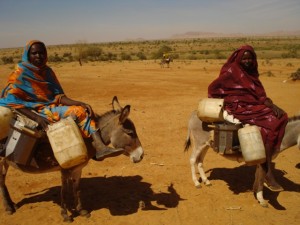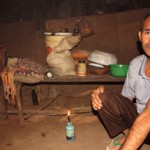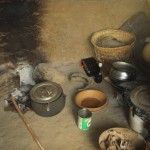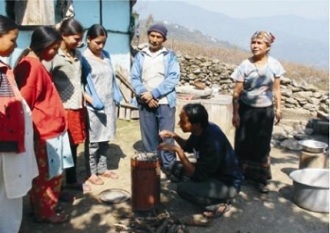Anadolu Kardiyol Derg Sept. 2011
Turkey: Evaluation of the effects of chronic biomass fuel smoke exposure on peripheral endothelial functions: an observational study
Ali Buturak, et al.
Objective: To evaluate the effect of chronic biomass fuel (BMF) smoke exposure on peripheral endothelial functions.
Methods: Forty-seven healthy subjects who have been exposed to BMF smoke since birth (mean age 31.6±6.8 years, 21 male) were enrolled in the present cross-sectional observational study. The control group consisted of 32 healthy subjects (mean age 27.9±4.4 years, 11 male). The carotid intima media thickness (CIMT), flow associated dilatation (FAD %) and endothelium independent vasodilatation (GTN %) were assessed in all subjects. The carotid CIMT was defined as the distance between the leading edge of the lumen–intima and the media–adventitia interfaces. FAD % was defined as the percentage change in the internal diameter of the brachial artery during reactive hyperemia related to the baseline. GTN % was defined as the change in diameter in response to the application of 400 μg of glyceril trinitrate relative to the baseline scan at the end of the fourth minute. Statistical analysis was performed using Student’s t-test, Chi-square test and Spearman rank order correlation analysis.
Results: The average exposure time of the subjects to biomass fuel smoke was 31.7±6.6 years. They have been exposed to dung inhalation products meanly 8.3±1.8 months in a year seasonally. The average daily exposure time was 15.7±3.3 hours. CIMT values of the two groups were not statistically different from each other (0.47±0.09 vs. 0.49±0.06 mm, p=0.138). However, a markedly reduced FAD % was determined in the study group (5.06±4.95 vs. 10.7±4.64, p<0.001). And GTN % of the BMF exposed group was significantly lower than the control group (14.41±8.47 vs. 21.85±7.87, p<0.001).
Conclusion: FAD % and GTN % are markedly reduced in the individuals who have been exposed to BMF smoke inhalation products. Therefore, chronic BMF smoke exposure may be a risk factor for the development of endothelial dysfunction.
Int. J. Epidemiol. (2011) doi: 10.1093/ije/dyq259
Household coal use and lung cancer: systematic review and meta-analysis of case–control studies, with an emphasis on geographic variation
Dean Hosgood III1, Hu Wei1, Amir Sapkota, Imran Choudhury, Nigel Bruce, Kirk R Smith, Nathaniel Rothman and Qing Lan
hosgoodd@mail.nih.gov
Background – Emissions from household coal combustion associated with cooking and heating are an important public health issue, particularly in China where hundreds of millions of people are exposed. Although coal emissions are a known human carcinogen, there is still uncertainty about the level of risk for lung and other cancers.
Methods – We performed a meta-analysis on 25 case–control studies (10 142 cases and 13 416 controls) to summarize the association between household coal use and lung cancer risk, and to explore the effect modification of this association by geographical location.
Results – Using random-effects models, household coal use was found to be associated with lung cancer risk among all studies throughout the world [odds ratio (OR) = 2.15; 95% confidence interval (CI) = 1.61–2.89, Nstudies = 25], and particularly among those studies carried out in mainland China and Taiwan (OR = 2.27; 95% CI = 1.65–3.12, Nstudies = 20). Stratification by regions of mainland China and Taiwan found a variation in effects across the regions, with south/southeastern (OR = 3.27; 95% CI = 1.27–8.42, Nstudies = 3) and southwestern China (OR = 2.98; 95% CI = 1.18–7.53, Nstudies = 3) experiencing the highest risk. The elevated risk associated with coal use throughout Asia was also observed when stratifying studies by gender, smoking status, sample size, design (population vs hospital case–control) and publication language. No significant publication bias was found (pBegg’s = 0.15).
Conclusions – Our results provide evidence that although the carcinogenic effect of coal use varies by location, coals from many locations exhibit elevated lung cancer risks.
Energy Policy, Aug 11, 2011
Improved stoves in India: A study of sustainable business models
Gireesh Shrimalia, Xander Slaskib, Mark C. Thurberb and Hisham Zerriffic.
Burning of biomass for cooking is associated with health problems and climate change impacts. Many previous efforts to disseminate improved stoves – primarily by governments and NGOs – have not been successful. Based on interviews with 12 organizations selling improved biomass stoves, we assess the results to date and future prospects of commercial stove operations in India. Specifically, we consider how the ability of these businesses to achieve scale and become self-sustaining has been influenced by six elements of their respective business models: design, customers targeted, financing, marketing, channel strategy, and organizational characteristics.
The two companies with the most stoves in the field shared in common generous enterprise financing, a sophisticated approach to developing a sales channel, and many person-years of management experience in marketing and operations. And yet the financial sustainability of improved stove sales to households remains far from assured. The only company in our sample with demonstrated profitability is a family-owned business selling to commercial rather than household customers. The stove sales leader is itself now turning to the commercial segment to maintain flagging cash flow, casting doubt on the likelihood of large positive impacts on health from sales to households in the near term.
How A Market-Based Approach Can Solve A Humanitarian Problem In Darfur, Forbes, August 2011, by Liliana Luper.
In the midst of a forgotten humanitarian crisis, an innovative women-led organization is bringing hope to women in Darfur. The Darfur Stoves Project seeks to protect Darfuri women by providing them with specially developed stoves which require less fuel, thereby decreasing women’s exposure to violence while collecting firewood and their need to trade food rations for fuel. Now in an effort to ensure the sustainability of the project, its leaders are applying business-based thinking to a humanitarian problem.

Photo courtesy od Oxfam
Almost half of people in the world cook their food and heat their homes by burning coal and biomass in open fires or basic stoves. This practice exposes women and children to excessive amounts of smoke, endangering their health. In Darfur, women must walk up to seven hours, three to five times a week, just to find a single tree with usable firewood to fuel their fires. This is time they could spend learning or improving their livelihoods. Outside the relative safety of the camps, they are vulnerable to acts of violence and sexual assault.
Started by a UC Berkeley scientist in 2005, the Darfur Stoves Project has distributed over 20,000 fuel-efficient Berkeley-Darfur Stoves. To ensure quick delivery during a humanitarian crisis, the stoves are given free of charge to women. However, this model is dependent on limited donor funding and may be difficult to sustain in the long-run.
For many stove projects around the world, creating a market for stoves instead of distributing them for free is seen as a way to ensure that the stoves are valued by users while maintaining the long-term sustainability of the project. With the help of marketing consultant Jan Maes, the Darfur Stoves Project is exploring this idea with the aim of bringing the Berkeley-Darfur Stove to even more women in need.
Based on his research with potential stove users and other relevant stakeholders in Darfur, Jan found several barriers to instituting a standard stoves-for-sale model, including a lack of financial liquidity. The project is currently testing potential solutions, ranging from a subsidized program to down payment/installment plans as well as free trial periods. Through a savings mechanism, stove users could turn their reduced firewood expenses into daily cash savings. Women could use the initial savings to help pay for the stove and continue to accumulate lump sums of cash for years afterwards. Selling the stoves will also create economic opportunities for women in Darfur. The stoves will be sold on consignment so women could be employed as selling agents, giving them a vital opportunity to earn a living while helping other women.
[click to continue…]

- Photo: Natalie Bailey/IRIN
PENE, 18 August 2011 (IRIN) – In Nusa Tenggara Timur (NTT), one of Indonesia’s least developed provinces, child mortality is nearly double the national average and traditions are partly to blame, say aid workers. In a practice thought to be healthy, mother and child are confined to an “umebubu”, a grass hut, for 40 days after delivery, with a wood fire burning and no ventilation.
The effects of smoke and acute respiratory illness (ARI) can be deadly. According to the World Health Organization (WHO), up to 40,000 children die of pneumonia in Indonesia every year, accounting for nearly 20 percent of all child mortality in the world’s fourth-largest country.
Today, ARI deaths are largely concentrated among the rural poor, a world away from the images of Indonesia’s booming economy, where burning wood for cooking and heat is common, together with a lack of electricity and high rates of malnutrition – a major factor in ARI, Martin Weber, a WHO medical officer of child and adolescent health, told IRIN.
“The exposure of children to smoke is not only a problem in the first 40 days, but the first year of life when the child is kept around the cooking fire and exposed to the smoke,” he said. “This is where traditional practices put children at risk.”
[click to continue…]
The Biomass Energy Initiative for Africa (BEIA) launched a new project in South Africa to create a market for efficient biomass stoves in order to reduce reliance on forests for traditional biomass. BEIA is administered by the World Bank Africa Energy Unit (AFTEG), under Energy Sector Management Assistance Program’s (ESMAP), Africa Renewable Energy Access (AFREA) Trust Fund, which is supported by the Government of the Netherlands.
As the implementing agency of this project, Restio Energy has been collaborating with German Technical Cooperation agency (GIZ) to develop a rural marketing and distribution strategy for the EcoZoom/StoveTec stove in South Africa. Designed at the Aprovecho Research Centre (Oregon, USA) and manufactured at Shengzhou Stove Manufacturers (Zhejiang, China), the Ecozoom/StoveTec stoves are made from aerated ceramic, sheet metal and cast-iron and come in two models: a one-door wood stove and a two-door wood- and charcoal unit. Compared to a three-stone fire, the stoves use at least 50 percent less wood/charcoal, cooks two to four times quicker and produces 70 percent less smoke and 50 percent less greenhouse gases.
[click to continue…]
Yesterday, we looked at the problem of energy shortages in Nigeria, one of Africa’s largest oil exporters, and how a shortage of kerosene is leading to depletion of the country’s forests as more people turn to wood and charcoal for their fuel needs. Across Africa an estimated 5 million hectares of tropical forest are lost annually, much of it because of fuel shortages.
Today, Sam Olukoya looks at a new program in the country that aims to reduce destruction of forests through the use of energy efficient stoves. The first part of our series looking at Nigeria’s cooking fuel issues is also here on our website.
Aug 11, 2011 – Nigeria Series Part 1: The shortage of kerosene that’s causing deforestation
In Nigeria, a shortage of kerosene — which most Nigerians use for cooking – is leading to depletion of the country’s forests. High kerosene prices have led many Nigerians to find alternative heat sources, including charcoal and firewood. Although Nigeria is the world’s sixth largest crude oil exporter, the country relies on imported refined petroleum products like gasoline, kerosene and diesel, in part because the refineries it does have are poorly maintained and barely operational. Sam Olukoya reports from Lagos. Tune in tomorrow, when Sam presents the second part of our series on cooking fuel in Nigeria, looking at an effort to stem deforestation through the use of energy efficient stoves.
Link to audio: http://fsrn.org/audio/nigeria-series-part-1-shortage-kerosene-that%E2%80%99s-causing-deforestation/8958
Energy Policy, Article in Press, 2011.
Health and climate benefits of cookstove replacement options
Andrew P. Grieshopa, et al,
The health and climate impacts of available household cooking options in developing countries vary sharply. Here, we analyze and compare these impacts (health; climate) and the potential co-benefits from the use of fuel and stove combinations. Our results indicate that health and climate impacts span 2 orders of magnitude among the technologies considered. Indoor air pollution is heavily impacted by combustion performance and ventilation; climate impacts are influenced by combustion performance and fuel properties including biomass renewability.
Emission components not included in current carbon trading schemes, such as black carbon particles and carbon monoxide, can contribute a large proportion of the total climate impact. Multiple ‘improved’ stove options analyzed in this paper yield roughly equivalent climate benefits but have different impacts on indoor air pollution. Improvements to biomass stoves can improve indoor air quality, which nonetheless remains significantly higher than for stoves that use liquid or gaseous hydrocarbons. LPG- and kerosene-fueled stoves have unrivaled air quality benefits and their climate impacts are also lower than all but the cleanest stoves using renewable biomass.
University Corporation for Atmospheric Research (UCAR) Researchers tackle meningitis in Africa’s Sahel
A trip to Ghana last February brought UCAR/NCAR researchers from different disciplines together to reduce meningitis in Africa’s Sahel region.
 The UCAR Meningitis Weather Project was launched in 2009 by Raj Pandya (EO), Mary Hayden (RAL/ISP), Tom Yoksas (Unidata), and Tom Hopson (RAL), with a grant from Google.org and partnerships with Ghana’s Navrongo Health Research Centre and the University of Ghana’s School of Public Health. The goal is to provide long-term weather forecasts in the Sahel that will help reduce outbreaks of meningitis by enabling local health providers to target vaccination programs more effectively.
The UCAR Meningitis Weather Project was launched in 2009 by Raj Pandya (EO), Mary Hayden (RAL/ISP), Tom Yoksas (Unidata), and Tom Hopson (RAL), with a grant from Google.org and partnerships with Ghana’s Navrongo Health Research Centre and the University of Ghana’s School of Public Health. The goal is to provide long-term weather forecasts in the Sahel that will help reduce outbreaks of meningitis by enabling local health providers to target vaccination programs more effectively.
The project also interested in research showing that people exposed to large amounts of indoor pollution (from cooking over open flames) are up to nine times more likely to contract meningitis. Raj, Mary, and Tom Hopson were already headed to Ghana in February for a weeklong research trip, so Christine joined them for a quick look at how air quality and indoor cooking might connect to meningitis.
From a base at Navrongo, the team collaborated with Ghanaian researchers to study the disease’s local context, improve forecasts of annual rains with enough spatial resolution and lead time to optimize the allocation of vaccines, and carry out air quality research.
[click to continue…]






